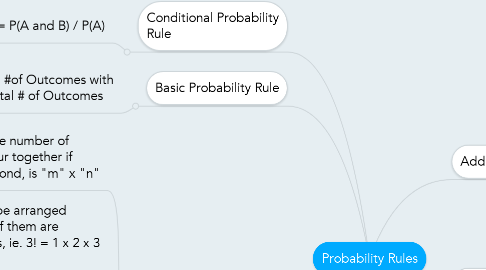Probability Rules
by Ashley Wright

1. Addition Rule ("OR")
1.1. (Not Mutually Exclusive) P(A or B) = P(A) + P(B) - P(A and B)
1.2. (Mutually Exclusive) P(A or B) = P(A) + P(B)
2. Multiplication Rule ("AND")
2.1. Dependent (no replacement) P(A and B) = P(A) x P(B given A)
2.2. Independent (replacement) P(A and B) = P(A) x P(B)
3. "Probability of at Least 1" Rule (Compliment Rule)
3.1. P(At Least 1 Evenet) = 1 - P(0 Event)
4. Conditional Probability Rule
4.1. P(A/B) = P(A and B) / P(A)
5. Basic Probability Rule
5.1. P(Event) = #of Outcomes with Event / Total # of Outcomes
6. 5 Counting Rules ("How Many?")
6.1. Fundamental Counting Rule - The number of ways 2 (or more) events can occur together if "m" is the 1st and "n" is the second, is "m" x "n"
6.2. Factorial Rule - # of diff ways objects can be arranged (permutations) of "n" items when all "n" of them are selected is N!(product of first "n" intergers, ie. 3! = 1 x 2 x 3 = 6)
6.3. Permutation Rule - The number of arrangements when "n" different items are available but only "r" are selected is "nPr". nPr = n! / (n-r)! *Remember to ask, "Does order matter?" - if Yes, use this*
6.4. Permutation Rule *when some items are identical* = n! / n1! n2! ....nk! (n1! + n2! ... +nk! must = total "n")
6.5. Combinations Rule - *Remember to ask, "Does order matter?", If No, use this* - Number of combos when "n" items are available but only "r" are selected w/o replacement is "nCr". (Arrangements of same items are counted as being the same)


